Gujarat Board GSEB Textbook Solutions Class 11 Biology Chapter 5 Morphology of Flowering Plants Textbook Questions and Answers.
Gujarat Board Textbook Solutions Class 11 Biology Chapter 5 Morphology of Flowering Plants
GSEB Class 11 Biology Morphology of Flowering Plants Text Book Questions and Answers
Question 1.
What is meant by modification of root? What type of modification of the root is found in the:
- Banyan tree
- Turnip
- Mangrove trees
Answer:
1. Banyan tree: Prop or Pillar roots; They are pillar-like adventitious roots, which arise from the heavy horizontal branches of a Banyan tree. (Ficus benghalensisve. Bargad). Initially, the roots are aerial and hygroscopic.
2. Turnip: Napiform (pitcher shaped) fleshy taproots; It is almost globular or top-shaped and tapers abruptly towards the apex. e.g. Turnip (Brassica repave. Pahalgam)
3. Mangrove trees: Pneumatophores or respiratory or breathing roots. They are aerial roots or aerophores found in mangrove plants, i.e. plants growing in swamps near the seashores such as Rhizophora, Sonneratia, Avicennia, Heritiera, etc
![]()
Question 2.
Justify the following statements on the basis of external features:
- Underground parts of a plant are not always roots.
- The flower is a modified shoot
Answer:
- Underground parts of a plant are not always roots: In some plants, stems remain underground to carry out some additional functions, like food storage and vegetative propagation. For example, Potatoes are a modified form of underground stem.
- A flower is a modified shoot: When the stem takes on the role of general reproduction it is modified into a flower. That is why a flower is often called a modified root.
Question 3.
How is a pinnately compound leaf different from a palmately compound leaf?
Answer:
In a pinnately compound leaf, a number of leaflets are present on a common axis, the rachis, which represents the midrib of the leaf as in Gulmohar. In palmately compound leaves the leaflets are attached at a common point i.e. at the tip of the petiole as in silk cotton.
![]()
Question 4.
Explain with suitable examples of the different types of phyllotaxy.
Answer:
Phyllotaxy is the pattern of arrangement of leaves on the stem or branch.
This is usually of three types alternate, opposite and whorled.
- An alternate arrangement of leaves: In the alternate type of phyllotaxy, a single leaf arises at each node in an alternate manner, as in China rose, mustard, and sunflower plants.
- Opposite arrangement of leaves: In opposite types, a pair of leaves arise at each node and lie opposite to each other as in Calotropis and guava plants.
- Whorled Arrangement of leaves: If more than two leaves arise at a node and form a whorl, it is called whorled, as in Alstonia.
Question 5.
Define the following terms:
- Aestivation
- Placentation
- Actinomorphic
- Zygomorphic
- Superior ovary
- Perigynous flower
- Epipetalous stamen
Answer:
- aestivation: The mode of arrangement of sepals or petals in the floral bud with respect to the other members of the same whorl is known as aestivation.
- placentation: The arrangement of ovules within the ovary is known as placentation.
- actinomorphic: When a flower can be divided into two equal radial halves in any radial plane passing through the center, it is said to be actinomorphic. Example: Mustard, Datura, Chilli.
- zygomorphic: When a flower can be divided into two similar halves only in one particular vertical plane, it is zygomorphic. Example: Pea, Gulmohar, Bean, Cassia.
- superior ovary: Also called Hypogynous flower. In the hypogynous flower, the gynoecium occupies the highest position while the other parts are situated below it. The ovary in such flowers is said to be superior.
Example: Mustard, China rose, Brinjal. - perigynous flower: If gynoecium is situated in the center and other parts of the flower are located on the rim of the thalamus almost at the same level, it is called perigynous – The ovary here is said to be half inferior. Example: Pium, Rose, Peach.
- epipetalous stamen: When stamens are attached to the petals, they are epipetalous. Example: Brinjal.
![]()
Question 6.
Differentiate between
- Racemose and cymose inflorescence
- Fibrous root and adventitious root
- Apocarpous and syncarpous ovary
Answer:
1. Differences between Racemose and cymose inflorescence
Racemose:
This is further divided into
- Raceme
- Catkin
- Spike
- Spadix
- Corymb
- Umbel or capitulum
2) Branches develop indefin¬itely and further branches arise laterally in an acropetal manner.
Cymose:
It is further divided into
- Mono- dichasial cyme
- Dichasial Cyme
- Polychasial cyme.
2) The branch arise from terminal buds and stop growing after some time. Lateral branches grow much vigorously and spread like a dome.
2. Differences between Fibrous root and Adventitious root
Fibrous root:
1) In monocotyledonous plants, the primary root is short-lived and is replaced by a large number of roots. Their roots originate from the base of the fibrous root system say, for example in wheat plants.
Adventitious root:
1) In some plants, say, for example, in grass and banyan tree there are roots arising from parts of the plant other than the radicle. These are called adventitious roots.
3. Differences between Apocarpous Ovary and Syncarpous Ovary
Apocarpous Ovary:
1) When more than one carpel is present, they may be free (as in lotus and rose) and are called the apocarpous ovary
Syncarpous Ovary:
1) They are termed syncarpous ovary when fused, as in mustard and tomato. After fertilization, the ovules develop into seeds and like an ovary matures into a fruit.
![]()
Question 7.
Draw the labeled diagram of the following:
- Gram seed
- V.S. maize seed
Answer:
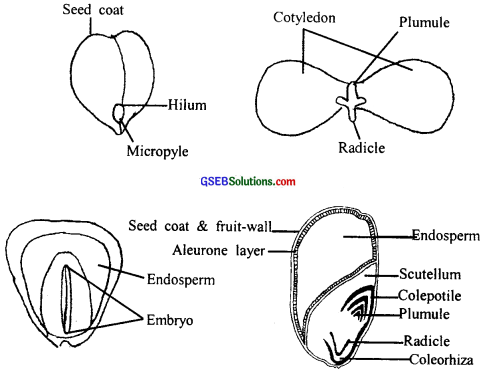
Question 8.
Describe modifications of the stem with suitable examples.
Answer:
Food storage:
Stems are modified to perform different functions. Underground stems of potato, ginger, turmeric, Samarkand, colocasia are modified to store food in them. They also act as organs of perennation to tide over conditions unfavorable for growth.
Tendrils:
Stem tendrils which develop from axillary buds, are slender and spirally coiled and help plants to climb such as in gourds (cucumber, pumpkins, watermelon) and grapevines.
Thorns:
Axillary buds of stems may also get modified into woody, straight and pointed thorns. Thorns are found in many plants such as citrus, Bougainvillea. They protect plants from browsing animals. Some plants of arid regions modify their stems into flattened (opuntia), or fleshy cylindrical (Euphorbia) structures. They contain chlorophyll and carry out photosynthesis.
Vegetative Reproduction:
Underground stems of some plants such as grass and strawberry, spread to new niches and when older parts die new plants are formed. In plants like mint and jasmine a slender lateral branch arises from the base of the main axis and after growing aerially for some time arch downwards to touch the ground. A lateral branch with short internodes and each node bearing a rosette of leaves and a tuft of roots is found in aquatic plants like Pistia and Eichhornia. In banana, pineapple, the lateral branches originate from the basal and underground portion of the main stem, grow horizontally beneath the soil and then come out obliquely upward giving rise to leafy shoots.

![]()
Question 9.
Take one flower each of the families Fabaceae and Solanaceae and write its semi-technical description. Also, draw their floral diagram after studying them.
Answer:
(a) Fabaceae: This family was earlier called Papilionoideae, a sub-family of family Leguminosae. It is distributed all over the world.
Vegetative characters: Trees, shrubs, herbs; root with nodules; leaves: alternate, pinnately compound or simple; leaf base, pulvinate; stipulate; venation reticulate.
Floral characters :
Inflorescence: racemose
Flower: bisexual, zygomorphic, calyx; Sepals: five, gamosepalous;
Corolla: Petals 5, polypetalous, papilionaceous, consisting of a pos¬terior standard, two lateral wings, two anterior ones forming a keel (enclosing stamens and pistil). Androecium: 10, diadelphous, anther dithecous; Gynoecium: ovary superior, single carpellary, unilocular with many ovules, style single; Fruit: legume; seed: one to many, non-endospermic.
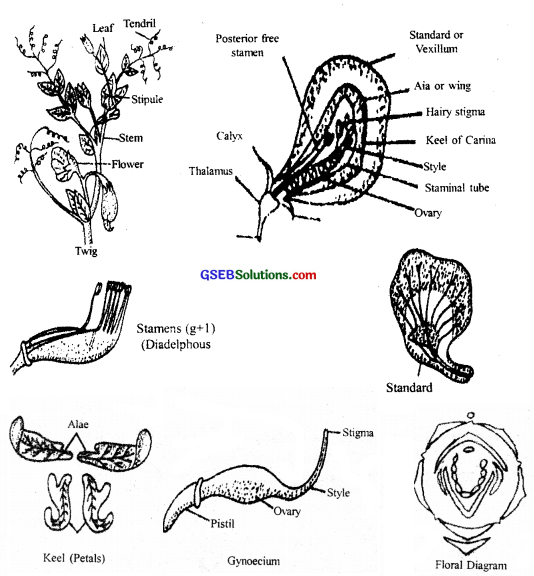
![]()
Economic importance: Many plants belonging to the family are sources of pulses (gram, arhar, sem, moong, soybean) edible oil (soybean, groundnut); dye (Indigofera); fibers (sun hemp); fodder (sesbania Trifolium) ornamentals (lupin, sweet pea); medicine (muliathi)
(b) Solanaceae: It is large. family, commonly called the potato family’. It is widely distributed in tropics, subtropics, and even temperate zones
Vegetative characters: Plants mostly herbs, shrubs, and small trees.
Stem – herbaceous rarely woody, aerial; erect, cylindrical, branched, solid or hollow, hairy or glabrous, underground stem in potato (Solanum tuberosum).
Leaves: Alternate, simple, rarely pinnately compound, exstipulate; venation reticulate.
Floral characters
Inflorescence: Solitary, axillary, or cymose as in solanum.
Flower: bisexual, actinomorphic
Calyx: sepals 5, united, persistent, valvate aestivation.
Corolla : petals 5, united; valvate aestivation.
Androecium: stamens 5, epipetalous.
Gynoecium: carpellary, syncarpous: ovary superior, bilocular, pla¬centa swollen with many ovules.
Fruits: berry or capsule.
Seeds: many, endosperms.
![]()
Economic Importance: Many plants belonging to this family are sources of food (tomato, brinjal, potato), spice (chili); medicine (belladonna, ashwagandha); Fumigatory (tobacco); ornamentals (petunia).
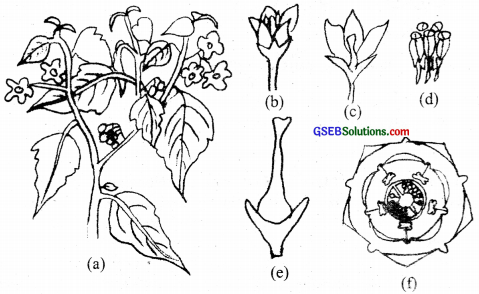
![]()
Question 10.
Describe the various types of placentations found in flowering plants.
Answer:
The arrangement of ovules within the ovary is known as placentation. The placentation is of different types namely
(a) marginal: In marginal placentation, the placenta forms a ridge along the ventral suture of the ovary and the ovules are borne on this ridge forming two rows, as in pea.
(b) Axile: When the placenta is axial and the ovules are attached to it in a multilocular ovary, the placentation is said to be axile, as in China rose, tomato and lemon.
(c) Parietal: In Parietal placentation, the ovules develop on the inner wall of the ovary or on the peripheral part. Ovary is one chambered but it becomes two-chambered due to the formation of the false septum. Example: Mustard and argemone. When the ovules are borne on a central axis and septa are absent, as in Dianthus and Primrose the placentation is called free central
(d) Basal: In basal placentation, the placenta develops at the base of the ovary and a single ovule is attached to it, as in sunflower, marigold.
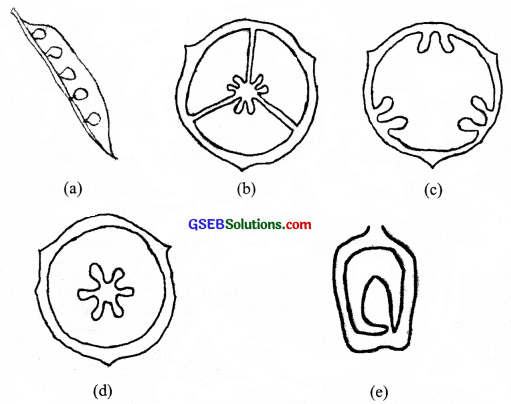
Question 11.
What is a flower? Describe the parts of a typical angiosperm flower.
Answer:
The flower is the reproductive unit in the angiosperms. It is meant for sexual reproduction.
A typical flower has four different kinds of whorls. arranged successively on the swollen end of the stalk or pedicel, called thalamus or receptacle. These are calyx, corolla, androecium, and gynoecium. Calyx and corolla are accessory organs, while androecium and gynoecium are reproductive organs. In some flowers like lily, the calyx and corolla are not distinct and are termed as perianth. When a flower has both androecium and gynoecium, it is bisexual. A flower having either only stamens or only carpels is unisexual.
In symmetry, the flower may be actinomorphic (radial) or zygomorphic (bilateral). When a flower can be divided into two equal radial haves in any radial plane passing through the center, it is said to be actinomorphic e.g. mustard, datura, chili. When it can be divided into two similar halves only in one particular vertical plane, it is zygomorphic e.g., pea, Gulmohar, bean, cassia. A flower is asymmetric (irregular) if it cannot be divided into two similar halves by any vertical plane passing through the center as in canna.
A flower may be trimerous, tetramerous, or pentamerous when the floral appendages are in multiples of 3,4, or 5, respectively. Flowers with bracts (reduced leaf found at the base of the medical) are called bracteate and those without bracts, ebracteate.
Based on the position of calyx, corolla, and androecium in respect of the ovary and thalamus, the flowers are described as: hypogynous; perigynous, and epigynous. In the hypogynous flower, the gynoecium occupies the highest position while the other parts are situated below it. The ovary in such flowers is said to be superior e.g., mustard, china-rose, and brinjal.
If gynoecium is situated in the center and other parts of the flower are located on the rim of the thalamus almost at the same level, it is called perigynous. The ovary here is said to be half inferior e.g., plum, rose, peach. In epigynous flowers, the margin of the thalamus grows upward enclosing the ovary completely, and getting fused with it, the other parts of the flower arise above the ovary. Hence, the ovary is said to be ‘inferior as in flowers of guava and cucumber, and the ray florets of sunflower.
![]()
Question 12.
How do the various leaf modifications help plants?
Answer:
Leaves are often modified to perform functions other than photosynthesis. They are converted into tendrils for climbing as in peas

or into spines for defense as in cacti. The fleshy leaves of onion and garlic store food. In some plants such as Australian acacia, the leaves are small and short-lived. The petioles in these plants expand, become green, and synthesize food. Leaves of certain insectivorous plants such as pitcher plants, venus fly traps are also modified leaves.
Question 13.
Define the term inflorescence. Explain the basis for the different types of inflorescence in flowering plants.
Answer:
The arrangement of flowers on the floral axis is turned into an inflorescence. Depending on whether the apex gets converted into a flower or continues to grow, two major types of the inflorescence are defined-racemose and cymose. This forms the basis for the different types of inflorescence in flowering plants. The flowers are borne in a basipetal order, as depicted in the figure.
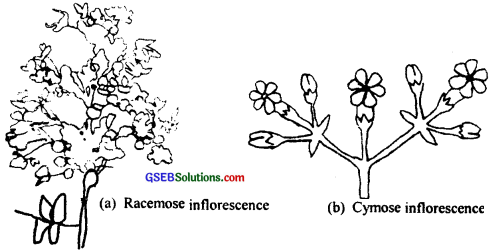
Question 14.
Write the floral formula of an actinomorphic, bisexual, hypogynous flower with five united sepals, five free petals, five free stamens, and two united carpels with the superior ovary and axile placentation.
Answer:
When a flower can be divided into two equal radial halves in any radial plane passing through the center, it is said to be actinomorphic eg. mustard, datura, chili.
![]()
Question 15.
Describe the arrangement of floral members in relation to their insertion on the thalamus.
Answer:
Based on the position of calyx, corolla, and androecium in respect of the ovary, on the thalamus, the flowers are described as
(a) hypogynous:
In the hypogynous flower, the gynoecium occupies the highest position while the other parts are situated below it. The ovary in such flowers is said to be superior. Example: Mustard, China rose, brinjal.
(b) Perigynous:
If gynoecium is situated in the center and other parts of the flower are located on the rim of the thalamus almost at the same level, it is called perigynous. The ovary here is said to be half inferior.
Example: Plum, Rose, Peach.
(c) Epigynous:
In epigynous flowers the margin of the thalamus grows upward enclosing the ovary completely and getting fused with it, the other parts of the flower arise above the ovary. Hence, the ovary is said to be inferior.
Example: Guava, Cucumber, Sunflower.